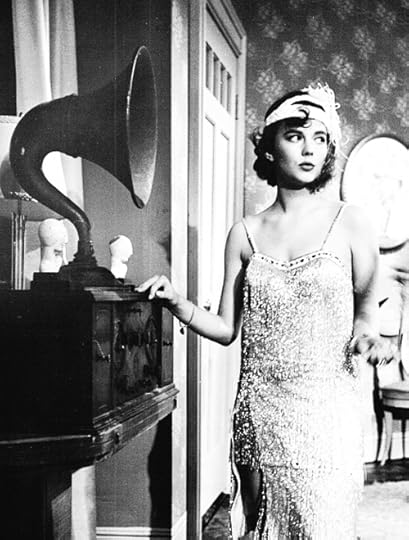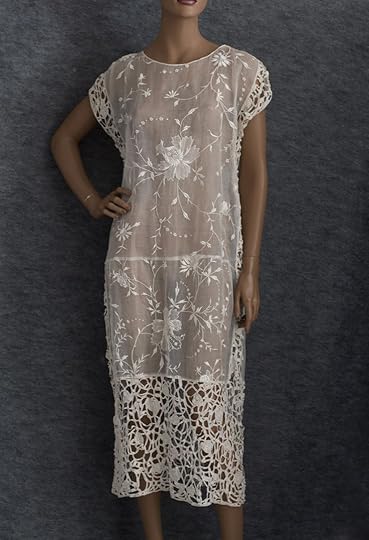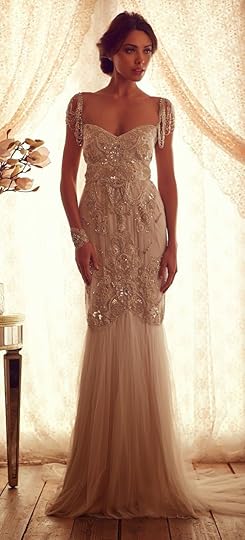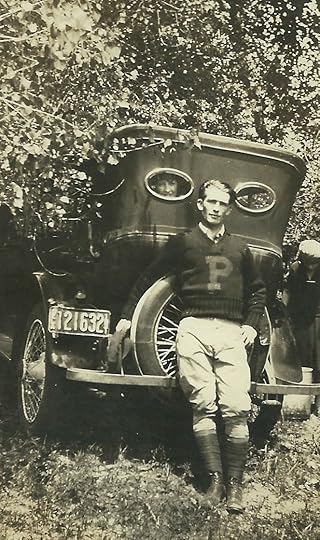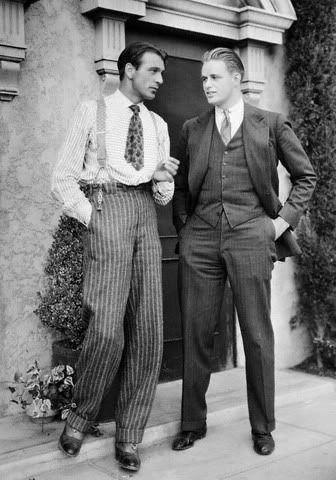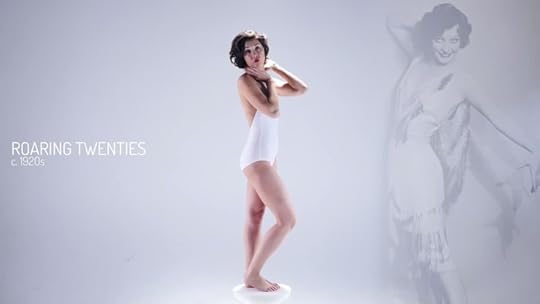Hᴏɢᴡᴀʀᴛs Sᴄʜᴏᴏʟ ᴏғ Wɪᴛᴄʜᴄʀᴀғᴛ ᴀɴᴅ Wɪᴢᴀʀᴅʀʏ ﹙Aɴ Aᴅᴠᴀɴᴄᴇᴅ Hᴀʀʀʏ Pᴏᴛᴛᴇʀ Rᴏʟᴇᴘʟᴀʏ﹚ discussion
Information
>
Time Period
date newest »
newest »
 newest »
newest »
message 1:
by
Hayley
(new)
Nov 08, 2015 08:35AM
 Mod
Mod
reply
|
flag
Fashion
Fashion in the 1920's England was a drastic change than the restrictive dresses that had come before, the skits and dresses were shorter, sportswear became available and clothing was overall more comfortable. The lines and cuts were simple and it flattered the bust rather than accentuating it.
Flapper Look
Tea Dress
Evening Dress
Sports Wear
Mens Wear
Ideal Body Type
The ideal body type for women during the 1920's was that of slim hips and a boyish figure with a reasonably flat chest. Clothes were made to help women achieve this type of body shape- i.e chemises and camisoles were made to flatten chests.
[image error]
Hair and Makeup
Women's hairstyles during the 1920's were short. There was the bob cut, shingle cut (a bob with a tapered back), Eton cut (very short, cut close to the head), finger waves, marcel waves and cropped waves.
With the invention of things like lipsticks, mascara (mascaros in the 1920's) and pan-sticks make up became easily accessible.
Eyes – kohled eyeshadow for the more daring girls
Eyebrows – Plucked for the first time and drawn downward towards the temple.
Lips – lips were smaller than the natural outline and fashioned into the ‘cupid’s bow’ shape.
Lashes – mascara was the new rage and no woman could resist enhancing her lashes.
Rouge – Applied in circles rather than angular. The effect was a rounded face.
Nails – The big name was Revlon and the popular style was the ‘moon manicure’ leaving the tip in painted.
Slang
◾Absent Treatment = Dancing with a bashful partner.
◾Airedale = A homely man.
◾Alarm clock = A chaperone
◾An alibi = A box of flowers
◾Anchor = Box of flowers or a bank roll
◾Apple Knocker = A hick; a hay-shaker.
◾Appleknocker = A hick
◾Applesauce = Flattery or bunk
◾Bank's Closed = No petting allowed; no kisses.
◾Barlow = A girl, a flapper, a chicken.
◾Barney = A scanal walker
◾Barneymugging = Lovemaking.
◾Bean-picker = One who tries to patch up trouble
◾Bee's Knees = See "Cat's Pajamas"
◾Bell Polisher = A young man addicted to lingering in vestibules at 1 a.m.
◾Berries = Great.
◾Berry Patch = A man's particular interest in a girl.
◾Big Timer = (n. masc.) = A charmer able to convince his sweetie that a jollier thing would be to get a snack in an armchair lunchroom; a romantic.
◾Billboard = Flashy man or woman.
◾Biscuit = A pettable flapper.
◾Blaah = No good.
◾Blouse = To go.
◾Blow = Wild party.
◾Blushing Violet = A publicity hound.
◾Boob-tickler = Girl who has to entertain her father's customers from out of town
◾Brooksy = Classy dresser
◾Brush Ape = Anyone from the sticks; a country Jake.
◾Bun Duster = See "Cake Eater".
◾Bush Hounds = Rustics and others outside of the Flapper pale.
◾Bust = A man who makes his living in the prize ring, a pugilist.
◾Butt me = Give me a cigarette
◾Cake Basket = A limousine.
◾Cake-Eater = A wearer of tight clothes, belted coat with spearlike lapels and one button, sausage trousers, low quick fitting collar, greenish pink shirt; and one of those jazzbo ties that gives you the giggles; a sissy; a harmless lounge lizard.
◾Cancelled Stamp = A wallflower.
◾Cat's Pajamas = Anything that's good
◾Cat's Particulars = The acme of perfection; anything that's good
◾Cellar Smeller = A young man who always turns up where liquor is to be had without cost.
◾Clothesline = One who tells neighborhood secrets.
◾Corn-shredder = Young man who dances on lady's feet
◾Crabhanger = Reformer
◾Crasher = Anyone who comes to parties uninvited.
◾Crashing Party = Party where several young men in a group go uninvited.
◾Crepe Hanger = Reformer.
◾Crumb Gobbler = Slightly sissy tea hound.
◾Cuddle-cootie = Young man who takes a girl for a ride on a bus.
◾Cuddler = One who likes petting.
◾Cutting yourself a piece of cake = Making yourself wait patiently
◾Dapper = A flapper's father
◾Darb = Gink with a roll of coin
◾Dewdropper = Young man who does not work, and sleeps all day.
◾Di Mi = Goodness.
◾Dimbox = A taxicab.
◾Dincher = A half-smoked cigarette.
◾Dingle Dangler = One who insists on telephoning.
◾Dipe Ducat = A subway ticket.
◾Dive-ducat = Subway ticket
◾Dog Kennels = Pair of shoes.
◾Dogs = Feet.
◾Dropping the Pilot = Getting a divorce.
◾Duck's Quack = The best thing ever.
◾Ducky = General term of approbation.
◾Dud = A wall flower
◾Dudding Up = Dressing.
◾Dumbbell = Wall flower with little brains.
◾Dumbdora = Stupid girl.
◾Dumkuff = General term for being "nutty" or "batty".
◾Ear muffs = Radio receivers
◾Edisoned = Being asked a lot of questions.
◾Egg harbor = A fall dance
◾Embalmer = A bootlegger.
◾Eye Opener = A marriage.
◾Face Stretcher = Old maid who tries to look younger.
◾Father Time = Any man over 30 years of age.
◾Feathers = Small talk; Light conversation.
◾Fig leaf = One piece bathing suit
◾Finale hopper = Young man who arrives after all the bills are paid.
◾Fire alarm = A divorced woman
◾Fire Bell = Married woman.
◾Fire Extinguisher = A chaperone.
◾Flap = Girl
◾Flat Shoes = Fight between a Flapper and her Goof
◾Flatwheeler = A poor young man who takes girls to free affairs
◾Floorflusher = Inveterate dance hound.
◾Flour Lover = Girl who powders too freely.
◾Fluky = Funny, odd, peculiar; different.
◾Forty-Niner = Man who is prospecting for a rich wife.
◾Frog's Eyebrows = Nice, fine.
◾Gander = Process of duding up.
◾Gimlet = A chronic bore.
◾Give Your Knee = Cheek-to-cheek or toe-to-toe dancing.
◾Given the Air = When a girl or fellow is thrown down on a date.
◾Goat's Whiskers = See "Cat's Particulars"
◾Goof = A flapper's sweetheart
◾Goofy = To be in love with, or attracted to. Example: "I'm goofy about Jack."
◾Green Glorious = Money and checks.
◾Grubber = One who always borrows cigarettes.
◾Grubstake = Invitation to dinner
◾Grummy = In the dumps, shades or blue.
◾Half cut = Happily intoxicated
◾Handcuff = Engagement ring.
◾Hen Coop = A beauty parlor.
◾Highjohn = Young man friend; sweetie, cutey, highboy.
◾Hikers = Knickerbockers
◾Hiphound = One who drinks hootch
◾His Blue Serge = His sweetheart.
◾Hopper = Dancer.
◾Horse Prancer = See "Corn Shredder".
◾Houdini = To be on time for a date.
◾Hush Money = Allowance from father.
◾Jane = A girl who meets you on the stoop.
◾John D. = An oily person
◾Johnnie Walker = Guy who never hires a cab.
◾Kippy = Neat or nice
◾Kitten's Ankles = See "Cat's Particulars".
◾Kluck = Dumb, but happy.
◾Lallygagger = A young man addicted to attempts at hallway spooning.
◾Lap = Drink.
◾Lemon Squeezer = An elevator.
◾Lens Louise = A person given to monopolizing conversation.
◾Let's blouse = Let's go
◾Low Lid = The opposite of highbrow.
◾Mad Money = Carfare home if she has a fight with her escort.
◾Meringue = Personality.
◾Monkey's Eyebrows = See "Cat's Particulars".
◾Monog = A young person of either sex who is goofy about only one person at a time.
◾Monologist = Young man who hates to talk about himself.
◾Mouthpiece = Lawyer
◾Mug = To osculate or kiss.
◾Munitions = Face powder and rouge.
◾Mustard Plaster = Unwelcome guy who sticks around.
◾Necker = A petter who puts her arms around a boy's neck.
◾Noodle Juice = Tea.
◾Nosebaggery = Restaurant.
◾Nut Cracker = Policeman's nightstick.
◾Obituary Notice = Dunning letter.
◾Oilcan = An imposter.
◾Orchid = Anything that is expensive.
◾Out on Parole = A person who has been divorced.
◾Petter = A loveable person; one who enjoys to caress.
◾Petting Pantry = Movie.
◾Petting Party = A party devoted to "hugging."
◾Pillow Case = Young man who is full of feathers.
◾Plastered = A synonym for pie-eyed; oiled; intoxicated
◾Police Dog = Young woman's fiance
◾Potato = A young man shy of brains.
◾Ritz = Stuck-up.
◾Ritzy Burg = Not classy.
◾Rock of Ages = Any woman over 30 years of age.
◾Rug Hopper = Young man who never takes a girl out. A parlor hound.
◾Sap = See "floorflusher."
◾Scandal = A short term for Scandal Walk.
◾Scandaler = A dance floor fullback. The interior of a dreadnaught hat, Piccadilly shoes with open plumbing, size 13.
◾Seetie = Anybody a flapper hates.
◾Sharpshooter = One who spends much and dances well.
◾Shifter = A grafter
◾Show Case = Rich man's wife with jewels.
◾Sip = Flapper term for female Hopper.
◾Slat = See "Highjohn"; "Goof".
◾Slimp = Cheapskate or "one way guy".
◾Smith Brothers = Guys who never cough up.
◾Smoke Eater = A girl cigarette user.
◾Smooth = Guy who does not keep his word.
◾Snake = To call a victim with vampire arms.
◾Snake-charmer = A female bootlegger
◾Snugglepup = A man fond of petting and petting parties.
◾Sod Buster = An undertaker.
◾Stander = Victim of a female grafter.
◾Static = Conversations that mean nothing.
◾Statts(?) = Conversation that means nothing
◾Stilts = Legs.
◾Strangler = What a spendthrift isn't
◾Strike Breaker = A young woman who goes with her friend's "Steady" while there is a coolness.
◾Stutter-tub = Motor boat
◾Sugar = Money
◾Swan = Glide gracefully.
◾Sweetie = Anybody she hates
◾They = Refers to objecting parents
◾Toddler = A finale hopper's faster sister
◾Tomato = Good looking girl with no brains
◾Trotzky (sic) = Old lady with a moustache and chin whiskers.
◾Umbrella = young man any girl can borrow for the evening.
◾Urban set = A new gown
◾Walk In = Young man who goes to a party without being invited.
◾Weasel = Girl stealer.
◾Weed = Flapper who takes risks.
◾Weeping Willow = See "Crepe Hanger"
◾Whangdoodle = Jazz-band music.
◾Whiskbroom = A man who cultivates whiskers.
◾Wind Sucker = Any person given to boasting.
◾Wurp = Killjoy or drawback.
Britain during the 1920's
What was it like to live in the 1920s? The 1920s, also known as the ‘Roaring Twenties’, was a decade of contrasts. The First World War had ended in victory, peace had returned and with it, prosperity.
For some the war had proved to be very profitable. Manufacturers and suppliers of goods needed for the war effort had prospered throughout the war years and become very rich. For the ‘Bright Young Things’ from the aristocracy and wealthier classes, life had never been better. Nightclubs, jazz clubs and cocktail bars flourished in the cities. The hedonistic lifestyle portrayed in books and films such as ‘The Great Gatsby’ was perhaps for some, an escape from reality. This generation had largely missed the war, being too young to fight, and perhaps there was a sense of guilt that they had escaped the horrors of war. Perhpas they felt a need to enjoy life to the full, because so many other young lives had been lost on the battlefields of Flanders.
P.G. Wodehouse and Nancy Mitford, herself a ‘Bright Young Thing’, portray the ‘Roaring Twenties’ in Britain in their novels. Both authors politely poke fun at the socialites and upper classes, but their novels give a good idea of the heady days of the 1920s.
The experiences during the War influenced British society, particularly women. During the war, many women had been employed in the factories, giving them a wage and therefore a certain degree of independence. Women over 30 had been given the vote in 1918, and by 1928 this had been extended to all women over the age of 21.
Women felt more confident and empowered, and this new independence was reflected in the new fashions. Hair was shorter, dresses were shorter, and women started to smoke, drink and drive motorcars. The attractive, reckless, independent ‘flapper’ appeared on the scene, shocking society with her wild behaviour. Girl Power 1920s-style had arrived!
For married women and their children, life was pretty much the same post-war as pre-war. For example, the middle-class stay-at-home housewife still changed into her afternoon dress after lunch to receive guests, and many such households had either a live-in maid or a ‘daily’ to help with household duties. Pregnant women normally gave birth at home and in a middle-class home, a live-in nurse was often engaged for the two weeks prior and for a month after the birth. For working class women there was no such luxury as a home help, and there was certainly no paternity leave for the husband!
Families were on average smaller in the 1920s than during the Victorian era, with families of 3 or 4 children most common. Children's toys were often homemade. Whip-and-top and skipping were popular pastimes. Carrot tops, turnip tops and wooden tops were whipped up and down the streets and pavements as there was little traffic. Comics such as “Chicks Own”, “Tiny Tots” and “School Friend” were available for children.
In 1921 the Education Act raised the school leaving age to 14. State primary education was now free for all children and started at age 5; even the youngest children were expected to attend for the full day from 9am to 4.30pm. In the country, pupils at some schools were still practising writing with a tray of sand and a stick, progressing to a slate and chalk as they became more proficient. Classes were large, learning was by rote and books were shared between groups of pupils, as books and paper were expensive. Nature study, sewing, woodwork, country dancing and traditional folk songs were also taught.
Sir Winston ChurchillBy the mid 1920s the post-war period of prosperity was well and truly over. The re-introduction of the Gold Standard by Winston Churchill in 1925 kept interest rates high and meant UK exports were expensive. Coal reserves had been depleted during the War and Britain was now importing more coal than it was mining. All this and the lack of investment in the new mass-production techniques in industry led to a period of depression, deflation and decline in the UK’s economy. Poverty amongst the unemployed contrasted strikingly with the affluence of the middle and upper classes.
By the mid 1920s unemployment had risen to over 2 million. Particularly affected areas were the north of England and Wales, where unemployment reached 70% in some places. This lead in turn to the Great Strike of 1926 (see picture below) and, following the US Wall Street crash of 1929, the beginning of the Great Depression of the 1930s.
From a decade that started with such a 'boom', the 1920s ended in an almighty bust, the likes of which weren't to be seen again for another eighty years.
(view spoiler)
Bright Young Things
Attention-seeking, flamboyant, decadent, rebellious, promiscuous, irresponsible, outrageous and glamorous; no, not the reality TV stars of today or the youth of the 1960s, but the original party animals – the ‘Bright Young Things’ of the 1920s.
You could say they started the modern cult of celebrity. Chased by the paparazzi who were fascinated by their outrageous behaviour, the ‘Bright Young Things’ were the younger sons and daughters of the aristocracy and middle-class people seeking to advance their careers through association.
What was the reason for this shocking behaviour? This was the generation that was too young to fight in the Great War. Perhaps their wild behaviour was a direct consequence of that 'War to end all Wars': the slaughter of so many young men had taught them to seize the day - ‘Carpe Diem’. Maybe it was a reaction against the values of their parents and those of pre-war Britain. Perhaps it was a response to the political, social and economic problems that followed the post-war boom. The old world was changing; many aristocratic families were now suffering financially due to crippling death duties and the resultant break up of estates after the war. Maybe for the girls, this shocking behaviour stemmed from their post-war new-found independence and confidence. Or perhaps it was a mixture of all of these things.
Amazingly, it all started with well-bred, modern young girls and their ‘treasure hunts’ around London using the public transport system; buses, trams and tubes. They chased around London, running and shouting and generally making a spectacle of themselves. This in turn led to young men becoming involved and the Bright Young Things took to treasure hunting in fast cars, roaring around the countryside.
These treasure or scavenger hunts evolved further, into weekend house parties, stunt parties and theatrical fancy dress parties. ‘Bring a Bottle’ parties were invented by the Bright Young Things at university in Oxford and Cambridge, as money was often tight for many of the students whose aristocratic families had been hit by death duties and taxes after the War.
The party set were obsessed with jazz which they saw as modern, raw and anti-establishment. They drank to excess, took drugs such as hashish, cocaine and heroin and indulged in licentious behaviour. They frequented the cocktail bars, jazz clubs and night clubs of London where they danced and drank till dawn.
They had their own argot or slang, using words such as ‘darling’, ‘divine’ and ‘bogus’. Men often behaved in a rather camp or effeminate manner, wearing makeup and flamboyant clothes; indeed, although gay and lesbian relationships were against the law in Britain in the 1920s, they were accepted by the Bright Young Things.
So who were these Bright Young Things? Perhaps the best known ‘celebrity’ of the times was Stephen Tennant, the youngest son of the Earl of Glenconnor, born in 1906. Outrageous in both his clothes and behaviour, it was said he spent most of his life in bed. His style was androgenous, rather like that of Boy George or David Bowie in the late 20th century. He was constantly pursued by the paparazzi. Nancy Mitford, herself one of the party set, is thought to have based the character Cedric in her novel ‘Love in a Cold Climate’ on Stephen.
Elizabeth Ponsonby was the original 1920s 'It' Girl who partied hard and drank herself to death before she was 40 years old. Brenda Dean Paul was an actress dubbed the ‘society drug addict’ by the press. In and out of rehab and prison, she reportedly ‘lived on brandy cocktails and salted nuts for years’.
Other members of the party set included Evelyn Waugh, John Betjeman, Noel Coward, Seigfried Sassoon the war poet and Cecil Beaton, the society photographer who was partly responsible for the public image of the Bright Young Things.
The press were fascinated by the wild behaviour of these young people. The 1920s could be seen as the start of the modern cult of celebrity. Some of the Bright Young Things used the press to further their own fame and notoriety; indeed some of their friends worked for the tabloid press as reporters.
So what happened to the Bright Young Things? The late 1920s saw a period of mass unemployment and economic decline in Britain. The wild and decadent behaviour of the party set was now becoming distasteful; people began to be irritated by the excesses of this group and the press became disenchanted with them. The Red and White Ball of November 1931 was perhaps the ‘party too far’. The dress code was ‘Red and White’; even the food was red and white. This whole show of excess was received with hostility and irritation by the media. Denounced by the press, this signalled the end for the ‘Bright Young Things’.
(view spoiler)
Minority Groups and Acceptance
Blacks
While the UK regarded blacks as full citizens and gave them the fullest protection of the law, blacks position in society was not great. The Upper and Middle Classes were casually and openly racist towards them but in most cases it didn't result in violence and the working class resented them because they took away work. Much of this racism is due to the fact blacks were mainly immigrants.
Homosexuality, Bisexuality and Pansexuality
Sexuality was a term that was being discussed in scientific circles but was not something that was accepted, indeed in the UK male homosexuality was illegal and punishable by imprisonment or visits to insane asylums. Female homosexuality however was not considered something viable due to females still mainly being viewed as housewives without any sexual desires.
Germans
Post War England were not as harsh on Germans as they had been during the war but the environment was still very hostile especially from those who had lost someone during the war, through some people held more tolerant attitudes.
Communism
People in the UK feared communism as much as they did in the US, maybe even more so due to Britain having a monarchy and aristocracy system in place. But the English did help displaced Russians who had fled to the country away from the violence.

